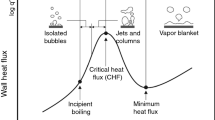Abstract
Bubble formation from a gas jet in a liquid cross flow inside the mixing conduit of an effervescent atomizer is studied using flow visualization. Air injection rates were varied from 0.99 × 10−5 to 4.94 × 10−5 kg/s, while maintaining a constant liquid cross-flow rate of 0.298 kg/s. Though gas–liquid ratio (GLR) and flow velocities dominate bubble formation, intermittent choking at the exit nozzle is shown to have a morphological impact on the bubbly flow. This impact is visible as a pressure wave that propagates upstream from the nozzle exit. This pulse is found to have a strong influence on bubble formation at the gas injection location leading to bubble distortion and breakup. In most cases, a liquid jet is observed to propagate through the centreline of larger bubbles as the pressure pulse passes.
Graphical Abstract







Similar content being viewed by others
References
Badam VK, Buwa V, Durst F (2007) Experimental investigation of regimes of bubble formation on submerged orifice under constant flow condition. Can J Chem Eng 85:257–267
Catlin CA, Swithenbank J (2001) Physical processes influencing effervescent atomizer performance in the slug and annular flow regimes. Atom Sprays 11:575–595
Ghaemi S, Rahimi P, Nobes DS (2010) Effect of bubble generation characteristics on effervescent atomization at low gas–liquid ratio operation. Atom Sprays 20(3):211–225
Huang X, Wang X, Liao G (2008) Visualization of two phase flow inside an effervescent atomizer. J Vis 11:299–308
Jedelsky J, Jicha M (2008) Unsteadiness in effervescent sprays: a new evaluation method and the influence of operational conditions. Atom Sprays 18:49–83
Gomez J, Fleck BA, Olfert J, McMillan J (2011) Influence of two-phase feed bubble size on effervescent atomization in a horizontal nozzle assembly. Atom Sprays 21:249–261
Kim JY, Lee SY (2001) Dependence of spraying performance on the internal flow pattern in effervescent atomizers. Atom Sprays 11:735–756
Konstantinov D, Marsh R, Bowen P, Crayford A (2010) Effervescent atomization for industrial energy-technology review. Atom Sprays 20(6):525–552
Lefebvre AH (1988) A novel method of atomization with potential gas turbine applications. Defense Sci J 38:353–362
Lefebvre AH (1989) Atomization and Sprays. Hemisphere Publishing Corporation, New York, USA
Lin KC, Kennedy PJ, Jackson TA (2001) Structures of internal flow and the corresponding spray for aerated-liquid injectors, 37th AIAA/ASME/SAE/ASEE Joint Propulsion Conference, AIAA 2001-3569, 8–11th July, Salt Lake City, Utah, USA
Maldonado S, Fleck B, Heidrick T, Amirfazli A, Chan EW, Knapper B (2008) Development of an experimental method to evaluate the stability of gas–liquid sprays. Atom Sprays 18:699–722
Roesler TC, Lefebvre AH (1988) Photographic studies on aerated-liquid atomization, combustion fundamentals and applications. In: Proceedings of the Meeting of the Central States Section of the Combustion Inst
Sovani SD (2001) High pressure gas–liquid flow inside and effervescent diesel injector and its effect on spray characteristics. PhD thesis, Purdue Universtiy
Acknowledgments
The authors acknowledge funding support for this research from Alberta Ingenuity Fund, the Natural Sciences and Research Council (NSERC) of Canada, and the Canadian Foundation of Innovation (CFI).
Author information
Authors and Affiliations
Corresponding author
Electronic supplementary material
Below is the link to the electronic supplementary material.
MPG (16490 KB)
Electronic supplementary material
MPG (21588 KB)
Rights and permissions
About this article
Cite this article
Sen, D., Balzan, M.A., Nobes, D.S. et al. Bubble formation and flow instability in an effervescent atomizer. J Vis 17, 113–122 (2014). https://doi.org/10.1007/s12650-014-0196-3
Received:
Revised:
Accepted:
Published:
Issue Date:
DOI: https://doi.org/10.1007/s12650-014-0196-3




